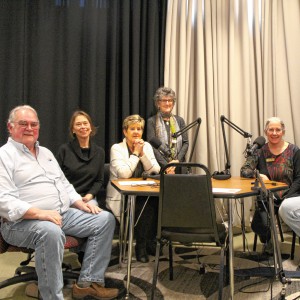Cluster development changes head to Greenfield City Council

Planning Board and Economic Development Committee members deliberate over proposed amendments to the city’s cluster development ordinance on Thursday. STAFF PHOTO/ANTHONY CAMMALLERI
| Published: 09-06-2024 6:17 PM |
GREENFIELD — After a joint meeting with the Economic Development Committee on Thursday evening, the Planning Board voted unanimously to recommend changes to the city’s cluster development ordinance.
The proposed changes were drafted alongside representatives from the Franklin Regional Council of Governments (FRCOG) to densify housing in the city’s more rural areas while preserving its open spaces.
The cluster development ordinance allows developers to build dense single-family, two-family and multi-family housing on a small portion of open space in the city’s Urban Residential, Suburban Residential and Rural Residential districts.
Addressing the Economic Development Committee and Planning Board, FRCOG’s Senior Land Use and Natural Resources Planner Allison Gage presented an overview on cluster developments and FRCOG’s two-year effort working with the city to draft the proposed amendments.
The ordinance’s proposed amendments allow the Planning Board, through the special permit process, to grant “density bonuses” to developers whose designs contain features that align with the city’s master plan.
The city could then allow developers to build 10% more housing units than otherwise allowed, if more than 20% of those units are designated as affordable under Chapter 40B.
Other design features that can earn a developer extra units include the creation of senior affordable housing; net-zero carbon sustainability; extra protection of land, trees or wildlife; and the orientation of rooftops to accommodate the installation of solar panels.
“We developed a bonus density system to further incentivize the building of more units with features that will benefit the community,” Gage said. “We base some of their criteria off of what neighborhood towns are offering, and the idea here is that if the developer includes a certain criteria, such as protecting extra open space above the required minimum, they would be awarded with a number of extra units they can build on the parcel.”
Article continues after...
Yesterday's Most Read Articles
The proposed amendments also alter the formula with which the number of dwelling units allowed on a development is calculated. Previously, the entirety of wetlands or federally protected lands would be subtracted from the total acreage, but under the proposed regulations, only 10% of protected land would be subtracted.
Resident and housing activist Mitchell Speight suggested to the board that, similar to the ordinance’s calculations of acreage to land, the city should regulate the creation of accessory dwelling units, or ADUs, based on the size of the unit’s host parcel. Residents Al Norman and Joan Marie Jackson echoed Speight’s remarks in separate statements to the board.
“I note that one of the purposes of the open space bylaw is to encourage the permanent preservation of open space. It seems contradictory for the city to be pushing new open space development regulations, while at the same time crowding our side and backyards with accessory dwelling units,” Speight said.
Zoning Board of Appeals Chair David Singer, who spoke as a resident during the public hearing, suggested that the Planning Board stipulate clear public notice requirements to ensure abutters of future developments are informed of the site plan and provided enough time to voice their concerns.
Precinct 2 City Councilor Rachel Gordon, who serves on the Economic Development Committee, suggested that the board edit Section I of the ordinance to include allowing the conveyance of open spaces to community land trusts that intend to develop affordable housing.
After brief discussion on whether Gordon’s proposed change to the ordinance was “substantive” enough to require additional public hearings, the Planning Board voted unanimously to recommend the changes to City Council.
Anthony Cammalleri can be reached at acammalleri@recorder.com or 413-930-4429.






 Literacy Project celebrating 40 years of education
Literacy Project celebrating 40 years of education River Rat Race returns for 60th year on April 12
River Rat Race returns for 60th year on April 12 Backyard Oasis, connecting older adults with podcasts, celebrates 50 episodes
Backyard Oasis, connecting older adults with podcasts, celebrates 50 episodes Stage on Main exhibit displays Athol resident’s work through the decades
Stage on Main exhibit displays Athol resident’s work through the decades
